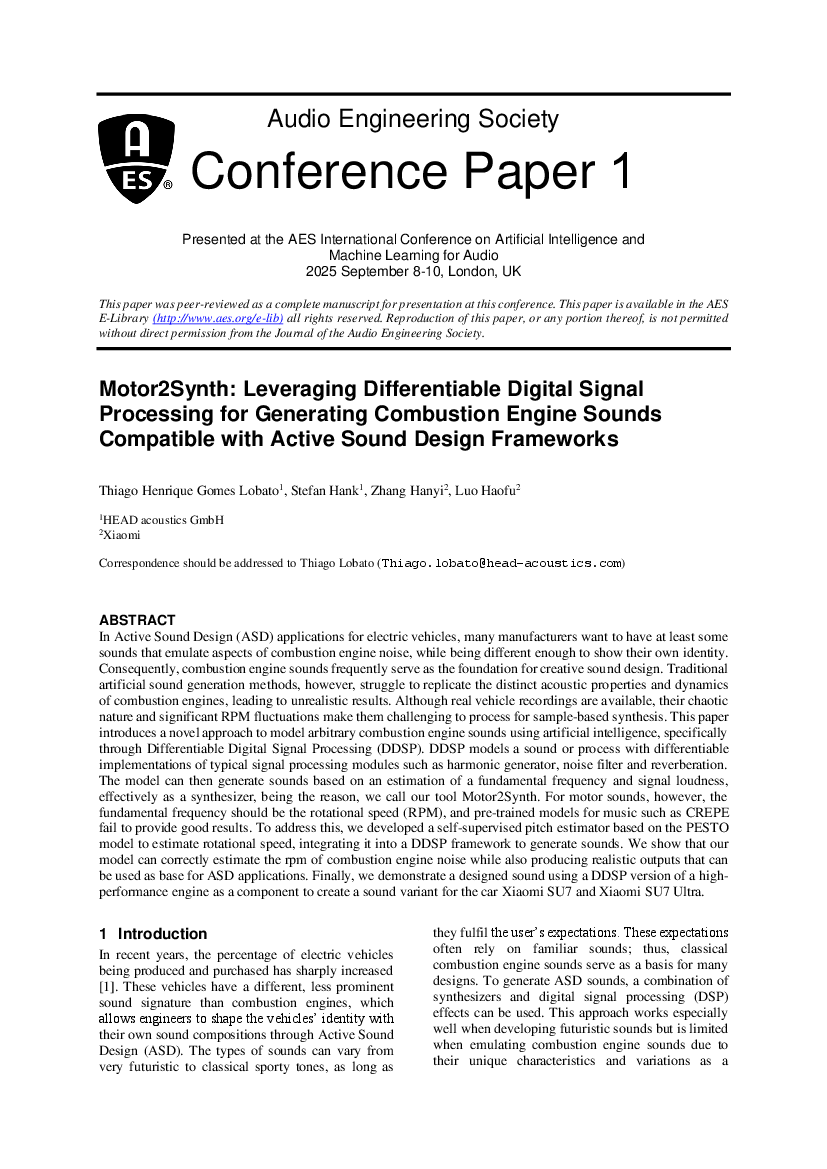Home / Publications / E-library page
You are currently logged in as an
Institutional Subscriber.
If you would like to logout,
please click on the button below.
Home / Publications / E-library page
Only AES members and Institutional Journal Subscribers can download
In Active Sound Design (ASD) applications for electric vehicles, many manufacturers want to have at least some sounds that emulate aspects of combustion engine noise, while being different enough to show their own identity. Consequently, combustion engine sounds frequently serve as the foundation for creative sound design. Traditional artificial sound generation methods, however, struggle to replicate the distinct acoustic properties and dynamics of combustion engines, leading to unrealistic results. Although real vehicle recordings are available, their chaotic nature and significant RPM fluctuations make them challenging to process for sample-based synthesis. This paper introduces a novel approach to model arbitrary combustion engine sounds using artificial intelligence, specifically through Differentiable Digital Signal Processing (DDSP). DDSP models a sound or process with differentiable implementations of typical signal processing modules such as harmonic generator, noise filter and reverberation. The model can then generate sounds based on an estimation of a fundamental frequency and signal loudness, effectively as a synthesizer, being the reason, we call our tool Motor2Synth. For motor sounds, however, the fundamental frequency should be the rotational speed (RPM), and pre-trained models for music such as CREPE fail to provide good results. To address this, we developed a self-supervised pitch estimator based on the PESTO model to estimate rotational speed, integrating it into a DDSP framework to generate sounds. We show that our model can correctly estimate the rpm of combustion engine noise while also producing realistic outputs that can be used as base for ASD applications. Finally, we demonstrate a designed sound using a DDSP version of a high-performance engine as a component to create a sound variant for the car Xiaomi SU7 and Xiaomi SU7 Ultra.
Author (s): Thiago Henrique Gomes Lobato, Stefan Hank, Hanyi Zhang andHaofu Luo
Affiliation:
Xiaomi
(See document for exact affiliation information.)
Publication Date:
2025-09-02
Import into BibTeX
Session subject:
Artificial Intelligence and Machine Learning for Audio
Permalink: https://aes2.org/publications/elibrary-page/?id=22990
(957KB)
Click to purchase paper as a non-member or login as an AES member. If your company or school subscribes to the E-Library then switch to the institutional version. If you are not an AES member Join the AES. If you need to check your member status, login to the Member Portal.

Thiago Henrique Gomes Lobato, Stefan Hank, Hanyi Zhang andHaofu Luo; 2025; Motor2Synth: Leveraging Differential Digital Signal Processing for Generating Combustion Engine Sounds Compatible with Active Sound Design Frameworks [PDF]; Xiaomi; Paper 1; Available from: https://aes2.org/publications/elibrary-page/?id=22990
Thiago Henrique Gomes Lobato, Stefan Hank, Hanyi Zhang andHaofu Luo; Motor2Synth: Leveraging Differential Digital Signal Processing for Generating Combustion Engine Sounds Compatible with Active Sound Design Frameworks [PDF]; Xiaomi; Paper 1; 2025 Available: https://aes2.org/publications/elibrary-page/?id=22990
@article{thiago2025motor2synth:,
author={thiago henrique gomes lobato stefan hank hanyi zhang andhaofu luo},
journal={journal of the audio engineering society},
title={motor2synth: leveraging differential digital signal processing for generating combustion engine sounds compatible with active sound design frameworks},
year={2025},
number={1},
month={november},}
TY – paper
TI – Motor2Synth: Leveraging Differential Digital Signal Processing for Generating Combustion Engine Sounds Compatible with Active Sound Design Frameworks
AU – Thiago Henrique Gomes Lobato, Stefan Hank, Hanyi Zhang andHaofu Luo
PY – 2025
JO – Journal of the Audio Engineering Society
VL – 1
Y1 – November 2025